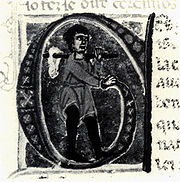
Cercamon
Encyclopedia

Troubadour
A troubadour was a composer and performer of Old Occitan lyric poetry during the High Middle Ages . Since the word "troubadour" is etymologically masculine, a female troubadour is usually called a trobairitz....
s. He was apparently a jester of sorts, born in Gascony
Gascony
Gascony is an area of southwest France that was part of the "Province of Guyenne and Gascony" prior to the French Revolution. The region is vaguely defined and the distinction between Guyenne and Gascony is unclear; sometimes they are considered to overlap, and sometimes Gascony is considered a...
, who spent most of his career in the courts of William X of Aquitaine
William X of Aquitaine
William X , called the Saint, was Duke of Aquitaine, Duke of Gascony, and Count of Poitou between 1126 and 1137. He was the son of William IX by his second wife, Philippa of Toulouse....
and perhaps of Eble III of Ventadorn
Eble III of Ventadorn
Eble III of Ventadorn was viscount of Ventadour . He was the son of Eble II, known as Eble le chanteur , and of Agnes de Montluçon...
. He was the inventor of the planh
Planh
The planh or plaing is a funeral lament used by the troubadours, modeled on the medieval Latin planctus. It differed from the planctus in that it was intended for a secular audience...
(the Provençal dirge), of the tenso
Tenso
A tenso is a style of Occitan song favoured by the troubadours. It takes the form of a debate in which each voice defends a position on a topic relating to love or ethics. Closely related genres include the partimen and the cobla exchange...
(a sort of rhymed debate in which two poets write one stanza each) and perhaps of the sirventes
Sirventes
The sirventes or serventes is a genre of Occitan lyric poetry used by the troubadours. In early Catalan it became a sirventesch and was imported into that language in the fourteenth century, where it developed into a unique didactic/moralistic type...
.
Most of the information we have about Cercamon's life is nothing but rumour and conjecture; some of his contemporaries credit him as Marcabru
Marcabru
Marcabru is one of the earliest troubadours whose poems are known. There is no certain information about him; the two vidas attached to his poems tell different stories, and both are evidently built on hints in the poems, not on independent information.According to the brief life in MS...
's mentor, and some circumstantial evidence
Circumstantial evidence
Circumstantial evidence is evidence in which an inference is required to connect it to a conclusion of fact, like a fingerprint at the scene of a crime...
points to him having died on crusade as a follower of Louis VII of France
Louis VII of France
Louis VII was King of France, the son and successor of Louis VI . He ruled from 1137 until his death. He was a member of the House of Capet. His reign was dominated by feudal struggles , and saw the beginning of the long rivalry between France and England...
.
About 7 of his lyrics survive, but not a single melody; unfortunately, the work of his that most contributed to his fame among his contemporaries, his pastoretas or pastourelles, are lost.
Cercamon simply means "world searcher" in medieval Occitan.

